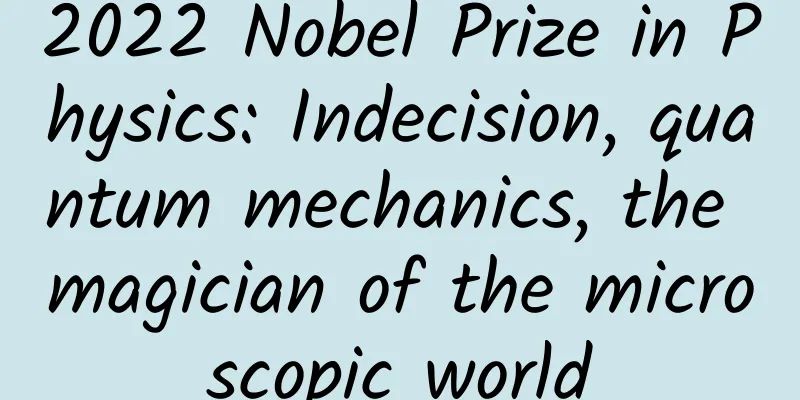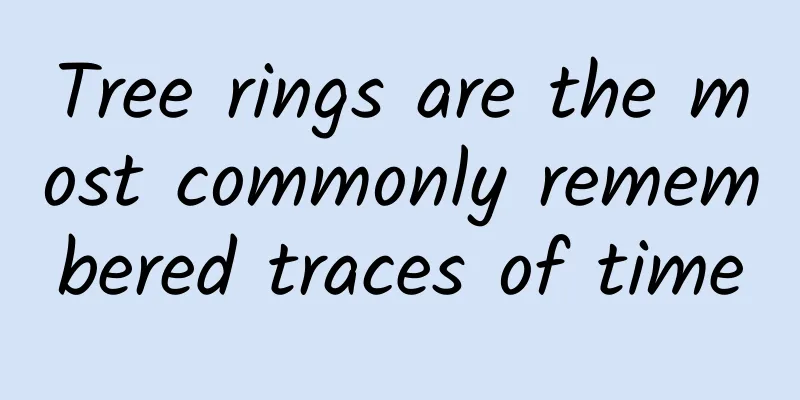2022 Nobel Prize in Physics: Indecision, quantum mechanics, the magician of the microscopic world

|
The 2022 Nobel Prize in Physics was announced at 17:45 Beijing time on October 4. The winners are French quantum mechanics physicists Alain Aspect, John F Clauser and Austrian physicist Anton Zeilinger. The reason for the award: They verified through photon entanglement experiments that Bell's inequality does not hold in the quantum world and pioneered the discipline of quantum information. Quantum information technology has been a hot topic among physicists in recent years, with many experts predicting that the field is on the cusp of exciting and significant developments. This could mean that quantum computers could eventually solve real-world problems faster than conventional computers. But the concepts behind this emerging technology could also lead to more sensitive medical diagnostic tools or more extensive secure communications networks. The three physicists pioneered early experiments showing that quantum particles can be linked, or entangled, so that one random behavior is much more strongly linked to the behavior of others than is intuitively possible. Quantum entanglement is at the heart of many of the latest advances in quantum technology. In the early 1980s, while working on his doctoral thesis, Alan Aspect conducted an experiment to verify Bell's inequality, which became known as the Aspect experiment, revealing the error of the EPR thought experiment conducted by Albert Einstein, Boris Podolsky and Nathan Rosen. The so-called "Bell's inequality" is the standard for judging whether Einstein's debate with Niels Bohr on "quantum mechanics" is complete based on the fact that "physical reality exists objectively independently of the observer" and "information transmission between particles does not exceed the speed of light and there is no local principle of action at a distance". This experiment is believed to be: under certain circumstances, secondary particles emitted in opposite directions at the same time can communicate with each other no matter how far apart they are. When one side is affected and changes direction, both sides will change direction at the same time. This may become the most important experiment of the 20th century. The experiment has also inspired some more "sharp" interpretations. For example, David Bohm, a physicist at University College London, believes that Aspect's findings mean that objective reality does not exist, and that although the universe looks concrete and solid, it is actually just a huge and detailed hologram-like illusion. This raises a sharp question: "Is the universe an objective reality, or just an illusion?" In fact, Einstein was always dissatisfied with the probabilistic interpretation of quantum mechanics. He once wrote to Bohr: "Although quantum mechanics is amazing, there is a voice in my heart telling me that it is not the real thing... I don't believe that God is throwing dice anyway!" After Bell's inequality experiment, Aspe also studied laser cooling of neutral atoms and Bose-Einstein condensation. Professor Anton Selinger has been actively promoting international academic exchanges and cooperation between China and Austria for decades. Since 1983, he has maintained long-term communication and exchanges with institutions such as the Chinese Academy of Sciences and the Chinese Academy of Engineering, and has established close cooperative relations with many units. Among them, using the "Micius" quantum science experimental satellite, his team cooperated in the intercontinental quantum communication experiment led by the Chinese Academy of Sciences, and realized the first quantum secure communication between Beijing and Vienna in the world. The results were selected as the top ten international physics advances in 2018 by the American Physical Society. Professor Selinger did his best to create conditions for Chinese scholars to participate in international exchanges and cooperation. In 2015, he organized the Austrian Academy of Sciences to hold the 26th General Assembly of the Academy of Sciences for the Developing World. Bai Chunli, President of the Chinese Academy of Sciences and President of the Academy of Sciences for the Developing World, and other people attended the meeting, which promoted international exchanges and cooperation among Chinese researchers. Professor Selinger was hired as an honorary professor of the University of Science and Technology of China, Nanjing University, and Xi'an Jiaotong University. He has trained 16 outstanding young and middle-aged academic talents for China, and co-published more than 60 papers in first-class international journals, helping them make important contributions in related fields. In addition to a unique certificate and gold medal, the prize money for the 2022 Nobel Prize is set at 10 million Swedish kronor (SEK), or about 6.4 million yuan, per award. So far, the Nobel Prize in Physics has been awarded 115 times , of which 47 were awarded to a single winner, 32 were shared by two winners, and 36 were shared by three winners. From 1901 to 2021, the Nobel Prize in Physics was awarded to 219 Nobel Prize winners . John Bardeen is the only winner who has won the Nobel Prize in Physics twice, in 1956 and 1972. This means that a total of 218 people have won the Nobel Prize in Physics. There are currently 6 Chinese winners of this award. In 1957, Tsung-Dao Lee and Chen-Ning Yang won the Nobel Prize in Physics for their discovery that parity is not conserved in weak interactions. In 1976, Ting Zhaozhong was awarded the Nobel Prize in Physics for discovering the bound state of the fourth quark - the J particle. In 1997, Chu won the Nobel Prize in Physics for "inventing a method of cooling and trapping atoms with lasers", along with American scientist William Phillips and French scientist Cohen Tanuj. In 1998, Tsui won the Nobel Prize in Physics for explaining the special phenomenon of electron quantum fluid. In 2009, Kao won the Nobel Prize in Physics for his groundbreaking achievements in the transmission of light in optical fibers for optical communications. According to People's Daily Online, the Nobel Prize in Physics is mainly concentrated in four fields: particle physics, astrophysics, condensed matter physics, atomic and molecular and optical physics . In the six years from 2015 to 2020, research results in the field of astrophysics have won the Nobel Prize in Physics four times: in addition to cosmological theory and exoplanets in 2019, there are neutrino oscillations in 2015 (belonging to astrophysics or particle physics) and the discovery of gravitational waves in 2017; and the discovery of black holes in 2020 also belongs to the field of astrophysics. Attached is the list of Nobel Prize winners in Physics in the past ten years and their contributions 2021 "For groundbreaking contributions to our understanding of complex systems" Syukuro Manabe and German scientist Klaus Hasselmann "for physical modeling of the Earth's climate, quantifying variability, and reliably predicting global warming" Giorgio Parisi "for his discoveries of the interplay of disorder and fluctuations in physical systems from the atomic to the planetary scale" 2020: Discovery of a Black Hole Roger Penrose "for discovering that the formation of black holes is a strong prediction of general relativity" Reinhard Genzel and American scientist Andrea Ghez "have discovered a supermassive compact object at the center of the Milky Way" 2019 "For contributions to our understanding of the evolution of the universe and the place of the Earth in it" James Peebles "for theoretical discoveries in physical cosmology" Michel Mayor and Didier Queloz "for the discovery of an exoplanet around a solar-type star" 2018 "Breakthrough Inventions in Laser Physics" Arthur Ashkin "for optical tweezers and their applications to biological systems" Gérard Mourou and Donna Strickland "for a method to generate high-intensity, ultrashort light pulses" 2017 "Seeing Gravitational Waves" Rainer Weiss, Barry C. Barish and Kip S. Thorne "for decisive contributions to the LIGO detectors and gravitational wave observations" 2016 "Discovery of a New Form of Matter" David J. Thouless, F. Duncan M. Haldane, and J. Michael Kosterlitz "for the theoretical discovery of topological phase transitions and topological phases of matter" 2015 “The Mass of Neutrinos” Takaaki Kajita and Arthur B. McDonald "for their discovery of neutrino oscillations, showing that neutrinos have mass" 2014 “Achieving White Light Source” Isamu Akasaki, Hiroshi Amano and Shuji Nakamura "for the invention of highly efficient blue light-emitting diodes that enable bright and energy-efficient white light sources" 2013 “Confirmation of elementary particles” François Englert and Peter W. Higgs "A theoretical discovery that contributes to our understanding of the mechanism of the origin of the masses of subatomic particles was recently confirmed by the discovery of a previously predicted elementary particle by the ATLAS and CMS experiments at CERN's Large Hadron Collider" 2012 "Measuring and manipulating single quantum systems" Serge Haroche and David J. Wineland "for a breakthrough experimental approach to measuring and manipulating single quantum systems" 2011 “Discovery of the accelerating expansion of the universe” Saul Perlmutter, Brian P. Schmidt, and Adam G. Riess, "for their discovery of the accelerating expansion of the universe through observations of distant supernovae" Comprehensive report by Jin Hongbin and Fang Jingyi from Chengshi Interactive |
<<: Today is Double Ninth Festival丨Thank you! The most important person in life!
>>: Can bananas cure constipation? The fruit that really relieves constipation is...
Recommend
A brief analysis of mobile Internet advertising fraud methods. How to prevent it?
1. Causes of Cheating Here I would like to first ...
How to increase user growth? A complete system architecture for user growth!
In the world of the Internet , everything is for ...
Draw a "circle" to save the planet's "neighbor"丨International Biosphere Reserve Day
A biosphere reserve is a protected area establish...
Coming next week! iOS 15 details revealed: improved multitasking, Apple's new notification banner design
WWDC2021 will officially kick off at 1 a.m. Beiji...
Apple responds to slow progress in iPhone 6s battery replacement: We don't have that much stock
The China Consumers Association recently issued an...
What you don’t know about the “harm value” of sitting for a long time: These massage and waist protection methods are actually wrong!
Author: Zhao Ping, Chief Physician of Air Force S...
It can "breathe fire"! Be careful when buying it
Can you buy a hair dryer for 15 yuan? Is it safe?...
How much does it cost to find an African to record a blessing video? Where can I buy the video of black people shouting slogans?
What is the most fashionable way to send blessing...
Why I don't buy an Apple Watch
[[128371]] Since the release of Apple Watch, it s...
A few words but a lot of meaning! A college admissions brochure with only one sentence
July 5 Northwestern Polytechnical University rele...
SEIA: U.S. solar installed capacity is expected to reach 324 GW by 2023
A report jointly released by the Solar Energy Ind...
A boundless lake appears in the desert, and the spring breeze blows through Yumen Pass?
Produced by: Science Popularization China Author:...
Ten writing secrets taught to me by a world-class master!
"The Shawshank Redemption" is adapted f...
eMarketer: Global connected car shipments to reach 69 million in 2020
199IT original compilation According to the lates...
How much is a pack of soft Zhonghua cigarettes: Chongqing corporate website promotion skills? The truth is revealed
Now more and more companies choose to do SEO prom...









